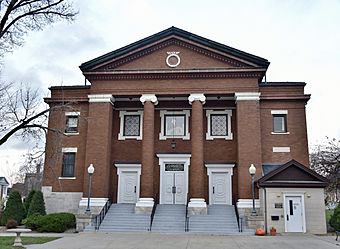Central Vinton Residential Historic District facts for kids
Quick facts for kids |
|
|
Central Vinton Residential Historic District
|
|

Presbyterian Church of Vinton (1913)
|
|
| Location | Roughly bounded by 2nd & D Aves., W. 13th & W. 6th Sts. Vinton, Iowa |
|---|---|
| Area | 50 acres (20 ha) |
| Architect | William F. Murphy Charles A. Dieman |
| Architectural style | Greek Revival Late Victorian |
| NRHP reference No. | 12000948 |
| Added to NRHP | November 21, 2012 |
The Central Vinton Residential Historic District is a special old neighborhood in Vinton, Iowa. It's recognized nationally as a historic district, which means it has many important old buildings. This district was added to the National Register of Historic Places in 2012. This list helps protect places that are important to American history.
This historic area covers about 50 acres and includes many old houses and other buildings. Most of these buildings are considered "contributing," meaning they add to the historical feel of the district. One unique feature is Second Avenue, which still has its original brick paving. Vinton is the county seat of Benton County, meaning it's where the county's government offices are located. Because Vinton was a busy center for business and government, this neighborhood grew a lot in the late 1800s.
Exploring Historic Homes
Most of the houses in this district were built before 1930. You'll find that over 90% of them are made of wood, while the rest are brick. These homes show off many different popular building styles from the late 1800s and early 1900s.
Popular Architectural Styles
As you walk through the Central Vinton Residential Historic District, you can spot many cool architectural styles. Each style has its own special look and features. Here are some of the styles you might see:
- Greek Revival: Often looks like ancient Greek temples with columns.
- Gothic Revival: Features pointed arches and steep roofs, like old European churches.
- Queen Anne: Known for its towers, turrets, and decorative details.
- Second Empire: Often has a distinctive mansard roof.
- Italianate: Features low-pitched roofs, wide eaves, and tall, narrow windows.
- Neoclassical: Similar to Greek Revival, with grand, formal designs.
- Tudor Revival: Looks like old English cottages with half-timbering.
- American Foursquare: Simple, boxy homes with a large porch.
- Colonial Revival: Inspired by early American colonial homes.
- American Craftsman: Focuses on natural materials and handcrafted details.
- Bungalow: Smaller, cozy homes often with a low-pitched roof and a front porch.
Historic Churches in the District
Besides houses, the district also includes three historic churches. These buildings are important parts of the neighborhood's history and architecture:
- First Baptist Church: Built in 1915, it features the Neoclassical style.
- Presbyterian Church of Vinton: Constructed in 1913, also in the Neoclassical style.
- Faith Independent Baptist Church: Built around 1920, showing the Gothic Revival style.



